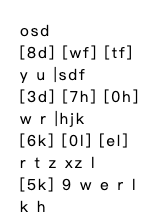Roblox Sheet

Roblox Sheet
Kiss the Rain
Yiruma
Trải nghiệm Kiss the Rain của Yiruma theo một cách hoàn toàn mới! Sử dụng bàn phím của bạn để chơi Kiss the Rain Roblox Bảng Nhạc Piano trên Bàn Phím Ảo. Dù bạn là một người chơi trò chơi piano roblox hay muốn luyện tập các tác phẩm cổ điển, bảng nhạc piano Roblox này sẽ giúp bạn dễ dàng tiến bộ từ người mới bắt đầu đến chuyên gia. Kiss the Rain nằm trong TOP 100 Bảng Nhạc Piano Roblox, cùng với rất nhiều bài hát dễ dàng, nhạc cổ điển, nhạc pop, nhạc Giáng sinh và bộ sưu tập nhạc Disney để bạn chơi!
1.5K lượt xem
Roblox Sheet

Roblox Sheet
Kiss the Rain
Yiruma
Trải nghiệm Kiss the Rain của Yiruma theo một cách hoàn toàn mới! Sử dụng bàn phím của bạn để chơi Kiss the Rain Roblox Bảng Nhạc Piano trên Bàn Phím Ảo. Dù bạn là một người chơi trò chơi piano roblox hay muốn luyện tập các tác phẩm cổ điển, bảng nhạc piano Roblox này sẽ giúp bạn dễ dàng tiến bộ từ người mới bắt đầu đến chuyên gia. Kiss the Rain nằm trong TOP 100 Bảng Nhạc Piano Roblox, cùng với rất nhiều bài hát dễ dàng, nhạc cổ điển, nhạc pop, nhạc Giáng sinh và bộ sưu tập nhạc Disney để bạn chơi!
119 lượt xem
Roblox Sheet

Roblox Sheet
Kiss the Rain
Yiruma
Trải nghiệm Kiss the Rain của Yiruma theo một cách hoàn toàn mới! Sử dụng bàn phím của bạn để chơi Kiss the Rain Roblox Bảng Nhạc Piano trên Bàn Phím Ảo. Dù bạn là một người chơi trò chơi piano roblox hay muốn luyện tập các tác phẩm cổ điển, bảng nhạc piano Roblox này sẽ giúp bạn dễ dàng tiến bộ từ người mới bắt đầu đến chuyên gia. Kiss the Rain nằm trong TOP 100 Bảng Nhạc Piano Roblox, cùng với rất nhiều bài hát dễ dàng, nhạc cổ điển, nhạc pop, nhạc Giáng sinh và bộ sưu tập nhạc Disney để bạn chơi!
72 lượt xem
Roblox Sheet

Roblox Sheet
Kiss The Rain
Yiruma
Trải nghiệm Kiss The Rain của Yiruma theo một cách hoàn toàn mới! Sử dụng bàn phím của bạn để chơi Kiss The Rain Roblox Bảng Nhạc Piano trên Bàn Phím Ảo. Dù bạn là một người chơi trò chơi piano roblox hay muốn luyện tập các tác phẩm cổ điển, bảng nhạc piano Roblox này sẽ giúp bạn dễ dàng tiến bộ từ người mới bắt đầu đến chuyên gia. Kiss The Rain nằm trong TOP 100 Bảng Nhạc Piano Roblox, cùng với rất nhiều bài hát dễ dàng, nhạc cổ điển, nhạc pop, nhạc Giáng sinh và bộ sưu tập nhạc Disney để bạn chơi!
45 lượt xem
Roblox Sheet

Roblox Sheet
Kiss The Rain
Yiruma
Trải nghiệm Kiss The Rain của Yiruma theo một cách hoàn toàn mới! Sử dụng bàn phím của bạn để chơi Kiss The Rain Roblox Bảng Nhạc Piano trên Bàn Phím Ảo. Dù bạn là một người chơi trò chơi piano roblox hay muốn luyện tập các tác phẩm cổ điển, bảng nhạc piano Roblox này sẽ giúp bạn dễ dàng tiến bộ từ người mới bắt đầu đến chuyên gia. Kiss The Rain nằm trong TOP 100 Bảng Nhạc Piano Roblox, cùng với rất nhiều bài hát dễ dàng, nhạc cổ điển, nhạc pop, nhạc Giáng sinh và bộ sưu tập nhạc Disney để bạn chơi!
41 lượt xem



















